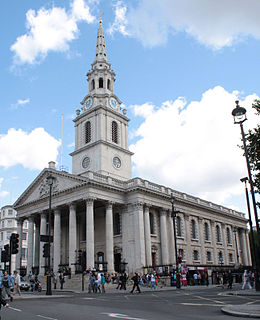St. Martin's in the Fields
| St Martin-in-the-Fields | |
|---|---|

2011
|
|
| Location |
Westminster London, WC2 |
| Country | England |
| Denomination | Church of England |
| Website | www |
| History | |
| Dedication | Saint Martin |
| Architecture | |
| Status | Parish church |
| Functional status | Active |
| Heritage designation | Grade I |
| Architect(s) | James Gibbs |
| Architectural type | Church |
| Style | Neoclassical |
| Years built | 1721–1726 |
| Specifications | |
| Number of spires | 1 |
| Spire height | 192 feet (59 m) |
| Bells | 12 (full circle) |
| Tenor bell weight | 29 long cwt 1 qr 1 lb (3,277 lb or 1,486 kg) |
| Administration | |
| Deanery | Westminster (St Margaret) |
| Archdeaconry |
London (previously Charing Cross) |
| Diocese | London |
| Province | Canterbury |
| Clergy | |
| Vicar(s) | Sam Wells |
| Laity | |
| Director of music | Andrew Earis |
| Churchwarden(s) | Chris Braganza Adrian Harris |
|
Listed Building – Grade I
|
|
| Official name: Church of St Martin in the Fields | |
| Designated | 24 February 1958 |
| Reference no. | 1217661 |
St Martin-in-the-Fields is an English Anglican church at the north-east corner of Trafalgar Square in the City of Westminster, London. It is dedicated to Saint Martin of Tours. There has been a church on the site since the medieval period. The present building was constructed in a Neoclassical design by James Gibbs in 1722–1726.
Excavations at the site in 2006 led to the discovery of a grave from about 410 AD. The site is outside the city limits of Roman London (as was the usual Roman practice for burials) but is particularly interesting for being so far outside, and this is leading to a reappraisal of Westminster's importance at that time. The burial is thought by some to mark a Christian centre of that time (possibly reusing the site or building of a pagan temple).
The earliest extant reference to the church is from 1222, with a dispute between the Abbot of Westminster and the Bishop of London as to who had control over it. The Archbishop of Canterbury decided in favour of Westminster, and the monks of Westminster Abbey began to use it.
Henry VIII rebuilt the church in 1542 to keep plague victims in the area from having to pass through his Palace of Whitehall. At this time, it was literally "in the fields", an isolated position between the cities of Westminster and London.
By the beginning of the reign of James I, the church had become inadequate for the size of its congregation, due to the great increase in population in the area. In 1606 the king granted an acre of ground to the west of St. Martin's Lane for a new churchyard, and the building was enlarged eastwards over the old burial ground, increasing the length of the church by about half. At the same time the church was, in the phrase of the time, thoroughly "repaired and beautified". Later in the 17th century capacity was further increased with the addition of galleries. The creation of the new parishes of St Anne, Soho, and St James, Piccadilly, and the opening of a chapel in Oxenden Street also relieved some of the pressure on space.
...
Wikipedia
